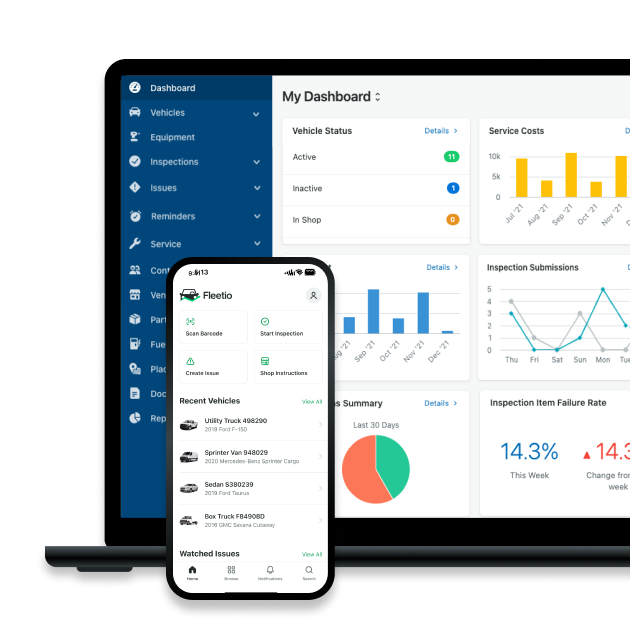What is alignment?
A car’s alignment refers to how the angles of the wheels are adjusted. When a technician or fleet repair shop performs an alignment, they adjust the angle of the wheels to the manufacturer’s specification or the range allowed. Proper alignment is of utmost importance when it comes to keeping your assets properly maintained and optimized for cost and performance.
What causes bad wheel alignment?
In the course of regular vehicle use, wheels can come out of alignment for a variety of reasons, including:
- Driving over potholes
- Hitting curbs or road debris
- Minor vehicle collisions
- Bad shocks, struts or other suspension parts
As you encounter adverse conditions on the road, your wheels can be knocked out of alignment, either by a single incident or a series of incidents over time. That’s why it’s important to include realignments on a regular interval in your vehicle preventive maintenance plans.
What can happen if you don’t get your vehicles realigned regularly?
Misaligned tire and wheel assemblies can have a big impact down the line. Your tires can wear out faster, which at best means you have to purchase new tires more frequently and at worst potential accidents due to a blowout on the road and associated insurance costs. Slight misalignments can also negatively impact your gas mileage, which artificially inflates your gas costs and cost per mile on your vehicles.
The good news is that strict preventive maintenance compliance can help you avoid any of the pitfalls of misalignment, allowing you to align your wheels regularly and ensure proper alignment. But sometimes, road conditions or driving behavior can impact your alignment before you get the opportunity to get a vehicle in for scheduled preventive maintenance.
Here are some of the most obvious signs that indicate that your vehicle might be due for an alignment service.
3 Major Signs of Tire Misalignment
Pulling To One Side
If your car is drifting to the center of the road or towards the shoulder, then you could have an alignment problem. You may find yourself continually applying pressure to the wheel to keep the car moving straight. The reason a car pulls to one side is usually due to the camber of the wheels. Camber refers to the angle at which the wheels are lined up with the road. The slightest wrong adjustment in camber will cause the car to veer to one side or the other.
Wandering
An inadequately aligned car may pull to one side because of camber, it can also have other steering problems because of caster, or the angle of the steering pivot. When viewed from the side, the caster may cause the steering pivot to lean back or forward. This makes steering in a straight line a constant battle. If it is positioned too far forward, or positive, it could make the steering jerky and too stiff.
Tire Wear
One of the most obvious symptoms of an incorrect alignment is tire wear. When the tires are misaligned, with regard to toe-in or camber, it causes areas of the tire to be overused and results in a shorter tire life. Excessively worn out treads on the outside of a tire can mean the camber is too positive, or there is too much toe-in. Inside wear indicates the opposite alignment problem with possible negative camber and/or misaligned toe out.
Keep track of tire conditions with digital inspections
See howCommon Misconceptions on Wheel Alignment
Many people believe that the easiest way to spot poor alignment is when it causes shaking while you drive. While any vibration of your vehicle while driving should definitely be cause for concern, shaking while driving is often caused by a worn-out tire that is out of round, or unbalanced tires, which is not necessarily the same thing as a misalignment. Worn tires may initially be a result of an alignment problem, but the shaking itself is because of the condition of the tires, not the alignment itself.
Regularly inspecting tires is a great item to include on daily pre-trip inspections and can help tip you off to any issues with alignment. Using a fleet maintenance app like Fleetio can make that process even simpler, with digital inspection forms that can be completed from drivers’ phones or tablets and automated work orders. You can even add alignment tasks to each asset’s individual PM schedule so you never miss an alignment.
Keep your wheels aligned and your maintenance on time with Fleetio. Start your free trial or request a demo today.


